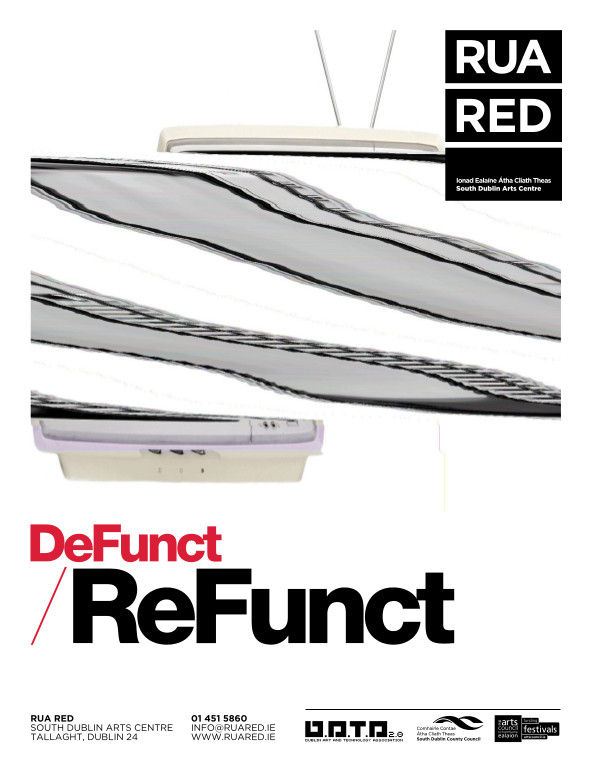Benjamin Gaulon (ed.): DeFunct/ReFunct, catalogue (2011)
Filed under catalogue | Tags: · art, circuit bending, error, glitch, hardware hacking, media art, physical computing, programming, recycling, technology

Mobile phones, communication devices, game consoles and PCs have short lifespans. How can we rethink, reuse and reinvent our e-waste? Hardware hacking, programming and physical computing are becoming part of artistic scope. There is a growing interest among artists and designers to know more about these domains of creation.
Catalogue for the DeFunct/ReFunct exhibition held in Rua Red, Dublin, as part of the Glitch Festival.
With texts by Benjamin Gaulon, Garnet Hertz & Jussi Parikka, Rosa Menkman, Alessandro Ludovico, Eduardo Navas, Phillip Stearns.
Featured artists: LoVid (Tali Hinkis and Kyle Lapidus), Gijs Gieskes, Recyclism (Benjamin Gaulon), MNK (Karl Klomp), TokTek (Tom Vebrugen), Rosa Menkman
Publisher RUA RED, Dublin, Ireland
ISBN 9780957077713
32 pages
Journal of Peer Production, No. 2: Bio/Hardware Hacking (2012)
Filed under journal | Tags: · biology, biotechnology, diy biology, hacker culture, hackerspace, hacking, hardware hacking
During the past two decades, hacking has chiefly been associated with software and computers. This is changing with the surge of synthetic biology, fablabs and hackerspaces, all of which suggests the wider diffusion of hacking practices and hacker politics. Hardware development and biological science are about to be infused with the same kind of contestations and contradictions that already characterize software hacking. This is because hackers are not simply innovating new technology, but are at the same time discovering new ways of engaging with the world. The issue highlights how hacking practices are inscribed in and shaped by the cultural and political contexts in which the hackers find themselves, with implications for the ways hacker politics are framed.
Contributions by Denisa Kera, Maxigas, Sara Tocchetti, Paolo Magaudda, Morgan Meyer, Mitch Altman
Curated by Alessandro Delfanti, Johan Söderberg
Published in July 2012
ISSN 2213-5316
View online (HTML articles)
Comment (0)Tom Igoe: Making Things Talk: Practical Methods for Connecting Physical Objects (2007)
Filed under book, manual | Tags: · arduino, code, gps, hardware hacking, locative media, network art, physical computing, processing, rfid

Building electronic projects that interact with the physical world is good fun. But when devices that you’ve built start to talk to each other, things really start to get interesting. Through a series of simple projects, you’ll learn how to get your creations to communicate with one another by forming networks of smart devices that carry on conversations with you and your environment. Whether you need to plug some sensors in your home to the Internet or create a device that can interact wirelessly with other creations, Making Things Talk explains exactly what you need.
This book is perfect for people with little technical training but a lot of interest. Maybe you’re a science teacher who wants to show students how to monitor weather conditions at several locations at once, or a sculptor who wants to stage a room of choreographed mechanical sculptures. Making Things Talk demonstrates that once you figure out how objects communicate — whether they’re microcontroller-powered devices, email programs, or networked databases — you can get them to interact.
Each chapter in contains instructions on how to build working projects that help you do just that. You will:
* Make your pet’s bed send you email
* Make your own seesaw game controller that communicates over the Internet
* Learn how to use ZigBee and Bluetooth radios to transmit sensor data wirelessly
* Set up communication between microcontrollers, personal computers, and web servers using three easy-to-program, open source environments: Arduino/Wiring, Processing, and PHP.
* Write programs to send data across the Internet based on physical activity in your home, office, or backyard
* And much more
With a little electronics know-how, basic (not necessarily in BASIC) programming skills, a couple of inexpensive microcontroller kits and some network modules to make them communicate using Ethernet, ZigBee, and Bluetooth, you can get started on these projects right away. With Making Things Talk, the possibilities are practically endless.
Published by O’Reilly, 2007
ISBN 0596510519, 9780596510510
426 pages
Key terms:
serial port, Bluetooth, RFID, Digi-Key, ASCII, Mac OS X, Arduino, serial communication, telnet, ZigBee, personal computer, breadboard, HTTP, Ethernet, myFont, Linux, accelerometer, rssi, sensor, potentiometer
Review (we make money not art)
More info (publisher)
More info (google books)

